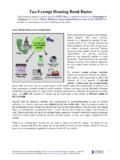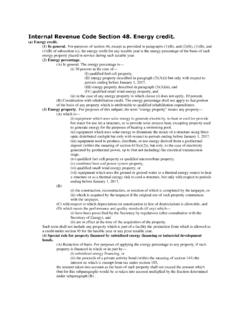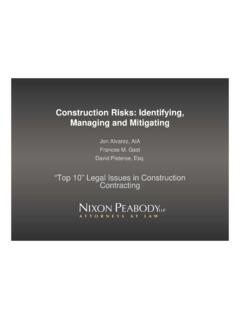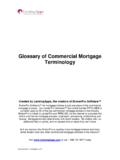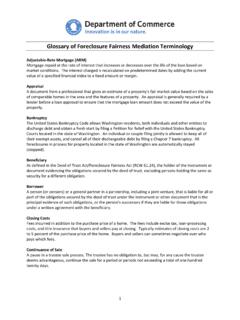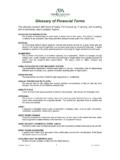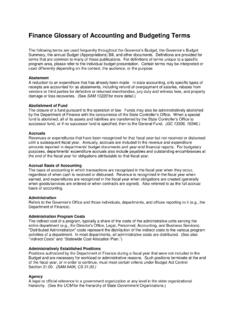Transcription of GLOSSARY OF LOW-INCOME HOUSING TAX CREDIT TERMS - …
1 100 Summer Street Boston, Massachusetts 02110-2131 (617) 345-1000 Fax: (617) 345-1300 GLOSSARY OF LOW-INCOME HOUSING TAX CREDIT TERMS 9% CREDIT means the annual CREDIT for the cost of a new building or a building substantially rehabilitated without a federal subsidy. For buildings placed in service after July 30, 2008, and before December 31, 2013, the CREDIT percentage for the 9% CREDIT shall equal not less than 9%. 4% CREDIT means the annual CREDIT for the cost of the acquisition of an existing building which is to be substantially rehabilitated or for the cost of a new building or substantial rehabilitation developed with a federal subsidy or tax-exempt bond financing. The 4% CREDIT is usually an amount less than 4 percent and it is also referred to as the 30% CREDIT . 20-50 Test means the minimum threshold set-aside under which 20% or more of the residential units are rent-restricted and rented to tenants with income 50% or less of area median gross income , adjusted for family size.
2 40-60 Test means the minimum threshold set-aside under which 40% or more of the residential units are rent-restricted and rented to tenants with income 60% or less of area median gross income , adjusted for family size. Accountant(s) means the independent certified public accountant(s) engaged by the owner of a LOW-INCOME HOUSING project for the purpose of reviewing, preparing, and certifying various reports as required by the low income HOUSING project s partnership or operating agreement or by applicable government agencies. Acquisition Cost means the cost to acquire an existing building. Acquisition CREDIT means the annual 4% CREDIT for the cost of buying an existing building for which substantial rehabilitation expenditures are incurred. Adjusted Basis means the cost basis of the property, adjusted upward for capital expenditures for, among other things, improvements, and adjusted downward for depreciation allowable.
3 Adjusted Investor Equity means the aggregate amount of cash taxpayers invested increased by cost-of-living adjustment. 2 Americans with Disabilities Act or ADA means the Americans with Disabilities Act of 1990 and the conforming federal, state and local rules and regulations. Applicable Federal Rate or AFR means the short term (less than 3 years), mid-term (3 to 9 years) and/or long-term (more than 9 years) debt rate that is re-determined on a monthly basis. Applicable Fraction means the portion of a building that is treated as low income , equal to the smaller of the Unit Fraction or the Floor Space Fraction. Applicable Percentage means the CREDIT percentage for which a qualified LOW-INCOME HOUSING building is eligible. Authority means a state or municipal HOUSING authority. Below-Market Federal Loan means a loan funded with federally appropriated dollars where the interest rate incurred is less than the Applicable Federal Rate.
4 Capital Account means the reflection of the partners equity in a partnership (or the members equity in an LLC), as adjusted periodically to take into account partnership (or LLC) operations. Capital Contribution means the total amount of cash and the fair market value of any property contributed or agreed to be contributed to a partnership (or LLC) by each partner or member thereof (without taking into consideration liabilities on the contributed property). Code means the Internal Revenue Code of 1986, as amended. Completion Date means the date the construction work on the project is certified as being substantially complete and in conformity with applicable building code requirements. Compliance Period means, with respect to any building, the period of 15 taxable years beginning with the first taxable year of the CREDIT Period with respect to such building. CREDIT Adjuster Provision means a provision in a partnership agreement or an operating agreement that takes into account any shortfall in the actual Tax Credits (versus the projected Tax Credits) for determining the investor s ultimate contribution to the project.
5 CREDIT Period means, with respect to any building, the period of ten taxable years beginning with the taxable year in which the building is placed in service or, at the election of the taxpayer, the succeeding taxable year, but only if the building is a qualified low income building as of the close of the first year or such period. CREDIT Recapture Amount means, collectively: (i) the amount of Tax CREDIT that must be paid back to the IRS (which can be up to 1/3 of the Tax Credits previously taken), and (ii) interest charges payable by the owner pursuant to Code Section 42(j)(2)(B). 3 Deep Rent Skewing Set-Aside Election means the election to rent at least 15% of the low income units ( , 15% of the minimum set-aside of the 20-50 Test or 40-60 Test) to tenants whose income is not greater than 40% of area median gross income , adjusted for family size. Depreciation means, for each fiscal year or other period, an amount equal to the depreciation deduction allowable with respect to an asset for such year, as provided for under the Code.
6 Developer means the developer of the low income HOUSING project. Difficult Development Area or DDA means any area designated by the Secretary of HOUSING and Urban Development as an area which has high construction, land, and utility costs relative to area median gross income . For buildings placed in service after July 30, 2008, a state agency can designate buildings to be treated like a DDA if additional credits are needed for financial feasibility and if not tax-exempt bond-financed. Eligible Basis means, generally, the Adjusted Basis of the building as of the close of the first taxable year of the CREDIT Period, as provided under Section 42(d) of the Code, which generally includes the cost of acquiring an existing building, construction costs, costs of acquiring personal property for use by the tenants and costs of facilities, such as swimming pools and parking lots, but does not include the cost of land and expenses related to permanent financing and syndication.
7 Existing Building means a building that has been previously placed in service. Extended LOW-INCOME HOUSING Commitment means the agreement between the taxpayer and the state HOUSING CREDIT agency which complies with Code Section 42(h)(6)(B), extends certain compliance provisions for the Tax CREDIT beyond the Compliance Period for at least an additional 15-year period, is binding on all successors of the taxpayer and must be recorded in the local real property records as a restrictive covenant. Federally Assisted Building means any building that is substantially assisted, financed or operated under laws in effect the date of enactment of the Tax Reform Act of 1986. Federally Subsidized means a building that is financed with a loan for which the interest income earned by the holder of the loan is exempt from tax under Code Section 103. Floor Space Fraction means the fraction, the numerator of which is the total floor space of the LOW-INCOME units in a building, and the denominator of which is the total floor space of the residential rental units (whether or not occupied) in such building.
8 Governmental Agency means any federal, state or local governmental agency or subdivision thereof or any of their respective agents, or any co-insurer under Sections 22l(d)(4) or 223(f) of the National HOUSING Act if acting in accordance with affirmative regulations of HUD. Grant means funds provided by a private foundation or charitable group, federal, state or local government that do not have to be repaid. Gross income means all income from whatever source derived, including the value of property or services as well as cash. 4 Hazardous Waste Laws means, usually, the Comprehensive Environmental Response, Compensation, and Liability Act of 1980, as amended (CERCLA); the Resource Conservation and Recovery Act of 1976, as amended; the Toxic Substances Control Act and any other federal, state or local statutes, ordinances, regulations or by-laws dealing with hazardous materials. HERA means the HOUSING and Economic Recovery Act of 2008, enacted into law on July 30, 2008.
9 HUD means the United States Department of HOUSING and Urban Development or any subdivision thereof or any of their respective agents. Imputed income Limitation means the appropriate percentage (50% if the 20-50 Test is being applied and 60% if the 40-60 Test is being applied) of area median gross income for a family of a size appropriate for the unit (one person if the unit has no separate bedroom or a number of persons equal to times the number of bedrooms). LLC means a limited liability company. Low income Unit means any of the dwelling units in a project which are to be held for occupancy in such manner as to qualify as qualified LOW-INCOME HOUSING units under Section 42(i)(3) of the Code. Minimum Set-Aside Test means the minimum set aside test selected with respect to the low income HOUSING project pursuant to Section 42(g) of the Code, generally either the 20-50 Test or the 40-60 Test. New Building means a building that was not placed in service prior to ownership by its current owner, although it may include qualifying substantial rehabilitation costs incurred with respect to existing buildings.
10 Nonqualified Nonrecourse Financing means nonrecourse financing that is not qualified commercial financing, as defined in Section 49(b) of the Code. Nonqualified Substantial Improvement means the costs of a substantial improvement that were depreciated under the 1981 through 1987 version of Section 168 of the Code or depreciated under former Section 167(k) of the Code (repealed in 1990). Placed-In-Service Date means the date on which a building is ready and available for its specifically assigned function, , the date on which the first unit in the building is certified as being suitable for occupancy in accordance with state or local law (often meaning the receipt of a certificate of occupancy). Project Documents means, generally, the construction contract, the mortgage loan documents, the regulatory agreement, and all other documents relating to the low income HOUSING project. 5 Qualified Basis means the product of a building s Applicable Fraction and the building s Eligible Basis, generally defined as the building's costs that are allocable to the units set aside for LOW-INCOME tenants.
